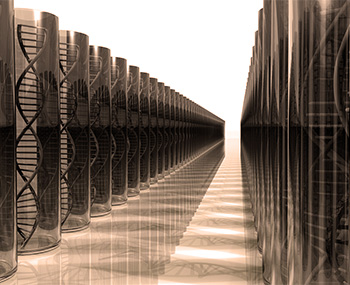47,000 Years of Aboriginal Genomics

Jeremy Eccles | 02.03.16
Author: Jeremy Eccles
News source: Press Release
The first complete sequences of the Y chromosomes of Aboriginal Australian men have revealed a deep indigenous genetic history tracing all the way back to the initial settlement of the continent c50 thousand years ago, according to a study published in the journal Current Biology on 25th February 2016.
The study by researchers from the Wellcome Trust Sanger Institute and collaborators at La Trobe University in Melbourne and several other Australian institutes, challenges a previous theory that suggested an influx of people from India into Australia around 4-5 thousand years ago. This new DNA sequencing study focused on the Y chromosome, which is transmitted only from father to son, and found no support for such a recent migration. The results instead show a long and independent genetic history in Australia.
Modern humans arrived in Australia about 50 thousand years ago, forming the ancestors of present-day Aboriginal Australians. They were amongst the earliest settlers outside Africa. They arrived in an ancient continent made up of today’s Australia, Tasmania and New Guinea, called Sahul, probably thousands of years before modern humans arrived in Europe.
Five thousand years ago, dingos, the native dogs, somehow arrived in Australia, and changes in stone tool use and the spread of the Pama-Nyungan language family over most of the mainland around the same time raised the question of whether there were also associated genetic changes in the Australian Aboriginal population. At least two previous genetic studies, one of which was based on the Y chromosome, had proposed that these changes could have coincided with mixing of Aboriginal and Indian populations about 5 thousand years ago.
Further study is needed to answer questions such as how the dingo did get to Australia and why other people such as the seafaring Polynesians didn’t settle on the continent. Expanding the genetic analyses beyond the Y chromosome and to the whole genome will also be necessary to completely rule out external genetic influences on the Aboriginal Australian population before the very recent times.
Comments from participants:
“We worked closely with Aboriginal Australian communities to sequence the Y chromosome DNA from 13 male volunteers to investigate their ancestry. The data show that Aboriginal Australian Y chromosomes are very distinct from Indian ones. These results refute the previous Y chromosome study, thus excluding this part of the puzzle as providing evidence for a prehistoric migration from India. Instead, the results are in agreement with the archaeological record about when people arrived in this part of the world.”
Anders Bergstrӧm, first author on the paper at the Wellcome Trust Sanger Institute
“Clearly there is keen interest in the Aboriginal community to explore their genetic ancestry and without them this study would not be possible – our first step was to return their results to them, before the scientific article was published. This collaboration in genome sequencing, to explore their ancient history, was made possible by years of engagement beforehand with Aboriginal communities.”
Dr John Mitchell, Associate Professor at La Trobe University in Melbourne
“As an Aboriginal Elder and cultural consultant for this project I am delighted, although not surprised, that science has confirmed what our ancestors have taught us over many generations, that we have lived here since the Dreaming.”
Lesley Williams, who was responsible for the liaison with the Aboriginal community
“By fully sequencing and analysing Y-chromosomal DNA, we have been able to trace ancient human migrations and inform living people about their ancestry. We are using the latest technology to genetically unearth our ancient history – something that has only become possible in the last decade. We look forward to further collaborations to understand more of this unique heritage.”
Dr Chris Tyler Smith, group leader at the Wellcome Trust Sanger Institute
And here are the origins of the Aboriginal Australian Individuals (and two Torres Strait Islanders) sampled for this study
ID Y Coverage Haplogroup Key Variant Paternal Origin
A45 19.74 C M130 Uncertain, possibly Normanton, Queensland
A268 13.06 C M210 Atherton Tablelands, Far North Queensland
A305 18.03 C M347 The Karryarra group located near Port Hedland, WA
A342 18.06 C M347 The Karryarra group located near Port Hedland, WA
A343 12.90 C M347 Northwest coast, near Broome, Western Australia
A136 12.61 K∗ M526 Kuranda, Far North Queensland
A179 18.85 K∗ M526 Gunganji tribe, Yarrabah, near Cairns, FNQ
A201 12.19 K∗ M526 Uncertain, but father’s people from SE Queensland
A266 19.07 K∗ M526 Gunganji tribe, Yarrabah, near Cairns, FNQ
A293 12.77 K∗ P308 Pilbara, Western Australia
A473 13.73 K∗ P308 Mount Isa region, Central Queensland
A238 16.42 M M186 Mer (Murray Island), Torres Strait, FNQ
A440 15.29 M M186 Mer (Murray Island), Torres Strait, FNQ
URL: http://www.sciencedirect.com/science/article/pii/S0960982216000786
Share this:
»  del.icio.us
»
del.icio.us
»  Digg it
»
Digg it
»  reddit
»
reddit
»  Google
»
Google
»  StumbleUpon
»
StumbleUpon
»  Technorati
»
Technorati
»  Facebook
Facebook
Contact Details
Further Research
News Tags: Aboriginal Australians | Current Biology | Genomics | Jeremy Eccles | La Trobe University | Out of Africa | Sahul | Welcome Trust | Y chromosone
News Archive
- 11.10.17 | RETURN OF MUNGO MAN
- 10.10.17 | TARNANTHI 2017
- 11.08.17 | Natsiaas 2017
- 08.08.17 | ABORIGINAL ART ECONOMICS
- 02.08.17 | SCHOLL'S NEXT MOVE
- 20.07.17 | APY ART DOMINATES THE WYNNE
- 17.07.17 | Anangu Artist Wins $100,000 Prize
- 14.07.17 | The End of AAMU
- 13.07.17 | YOU ARE HERE
- 11.07.17 | ART ACROSS THE COUNTRY
- 11.07.17 | TARNANTHI IN OCTOBER
- 05.07.17 | TJUNGUṈUTJA - from having come together
- 02.07.17 | BENNELONG
- 27.06.17 | JIMMY CHI
- 23.06.17 | Blak Markets at Barangaroo
Advertising

